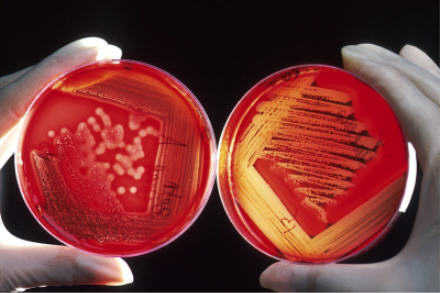
The Blood Of The Lamb
Grab a lab coat! Let’s learn some insights from the clinical laboratory. C’mon, it will be fun. I hope you find this information interesting. Well . . . I did anyway! But then, I am a medical technologist who worked in a clinical laboratory and a cancer research laboratory. When I considered the correlations from the laboratory setting to the spiritual setting, I got excited.
Not many folks care to talk about blood but that is our topic of discussion today. I bet you would be surprised to learn that sheep blood is used in numerous laboratory tests and pharmaceuticals. Why is that? Let’s take a look at some of those reasons.
Laboratory medicine is comprised of multiple disciplines, one of which is immunology, the study of the immune system. Words like “antigens, antibodies, T-cells, B-cells, receptor sites, RNA, DNA†are tossed around. We heard some of those buzz words during the coronavirus pandemic, didn’t we? Immunological testing was a primary focus in our cancer research lab and cell therapy testing.
A study at the Garvan Institute in Australia identified the RNA of sheep red blood cells (abbreviated SRBCs) to induce an immune response potentially useful in the development of human vaccines. Researchers discovered long ago that SRBCs are a crucial tool for immunology research as they bring about an extremely strong immune response. One thing we have learned through the pandemic is that more effective vaccination methods could prove beneficial for overall healthcare. The finding in Australia would be especially beneficial for vaccine development pertaining to autoimmune conditions such as diabetes and lupus.
Another immunology test in which SRBCs are used is a common laboratory method known as an ELISA (enzyme-linked immunosorbent assay). I can’t tell you how many ELISA tests I performed in my day. This test detects antibody response from T-cells such those that protect the body from cancer.

Another discipline of laboratory medicine in which SRBCs are significant is microbiology. One of the primary tasks in microbiology is the identification of bacteria and its response to drugs. How do SRBCs help with that? Most clinical specimens (e.g. throat swabs, wound swabs) are plated for growth and identification on a blood agar plate made from 5% SRBCs. The reason that sheep blood is used as a culture medium is because it is sensitive to hemolytic toxins released by bacteria. Hemolytic zones (clear or lysed areas) caused by the destruction of red blood cells around the colony growth appear for certain bacteria, thus assisting in the identification of the microorganism.
Blood agar is a rich medium that supports the growth of many disease-causing bacteria. Staphylococcus aureus is a prime example. Often referred to as a “Staph infection,†this microorganism appears as a thick yellow colony with yellow zones on a blood agar plate. A medical technologist will recognize this as a nasty bacterium. Streptococcus, or Step, is another easily recognized bacterium with significant hemolysis on a blood agar plate. Once a microorganism is identified and isolated, drug sensitivity and resistance testing can be done. This is useful in determining which drug should be prescribed to rid the infection.
Outside of the lab there are drug factories specializing in products derived from sheep antibodies. Serum, not red blood cells, is harvested from the blood after the sheep have been immunized. Antibodies are extracted and purified to form such products as: rattlesnake anti-venom, an antidote for Digoxin (heart drug) overdoses, a drug for septic shock, and an anti-cancer drug known as Prolarixâ„¢.
Who knew that sheep blood played such an integral role in the world of laboratory medicine and pharmaceuticals? More than likely it has played an indirect role in your own healthcare. Whether in the development of future vaccines, the identification of a skin or throat infection, the need for an emergent drug, sheep blood helps “save the day.â€
But the blood of sheep, or more specifically the blood of the Lamb, does more than save the day. The blood from The Good Shepherd, the Lamb of God, saves our souls. To make a laboratory analogy, His blood lyses our sin to clear a path for righteousness.
We learn throughout scripture that life is found in the blood. “The life of every creature is in its blood†(Leviticus 17:14). That’s why a blood sacrifice was required for purification of our sin. “I have given you the blood on the altar to purify you, making you right with the Lord. It is the blood, given in exchange for a life, that makes purification possible†(Leviticus 17:11). The only perfect blood sacrifice was through the perfect Lamb of God, Jesus Christ. “God paid a ransom to save you from the empty life you inherited from your ancestors. And the ransom he paid was not mere gold or silver. It was the precious blood of Christ, the sinless, spotless Lamb of God†(I Peter 1:18, 19).
I don’t need a lab test to tell me I need to be saved and that my sins need to be forgiven. Hallelujah! “The Lord is my Shepherd, I shall not want†(Psalm 23:1).
2 Comments
Leave a Comment
Follow This Blog
Ewe R Blessed Ministries / Karen O. Allen

Much I knew (have been blessed to work with LabCorp in the past and learned a great deal); the analogies you draw are both eye-opening and inspiring Ms. Karen. Thank you and great to see you writing and posting again ma’am.
I’m curious as to your affiliations with LabCorp, a prominent business in our area. Hallelujah, the blood of THE lamb is our lifeline to heaven. I am delighted to be posting again. Feels good.